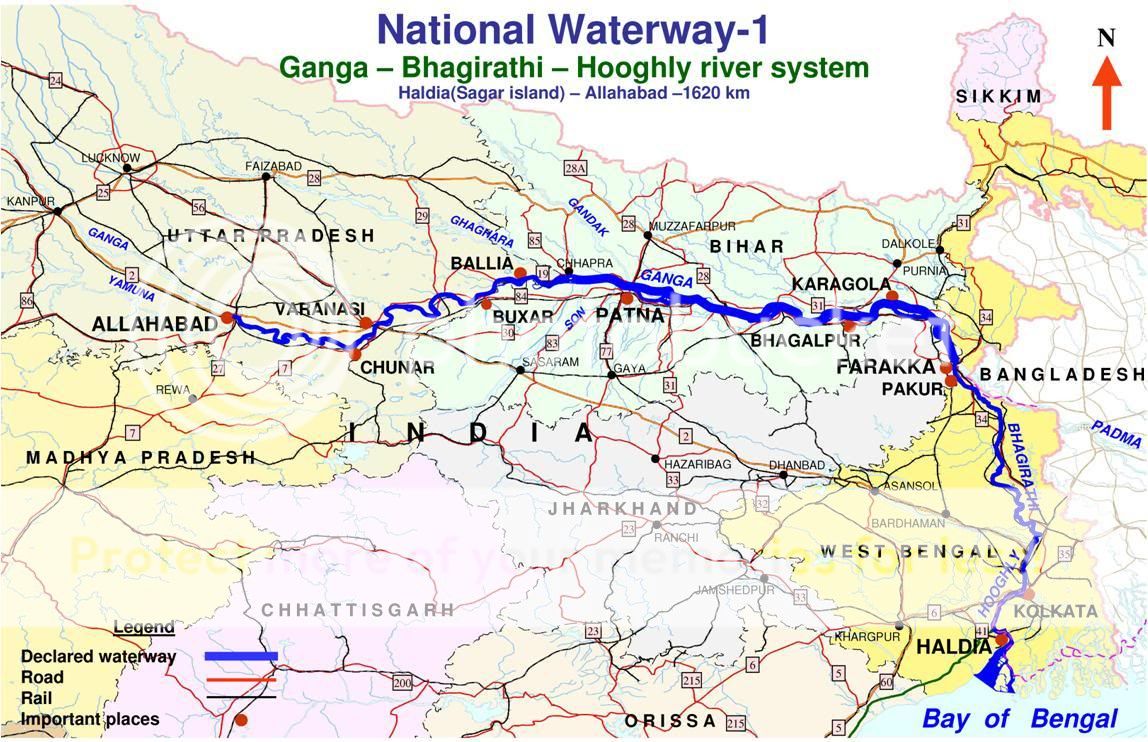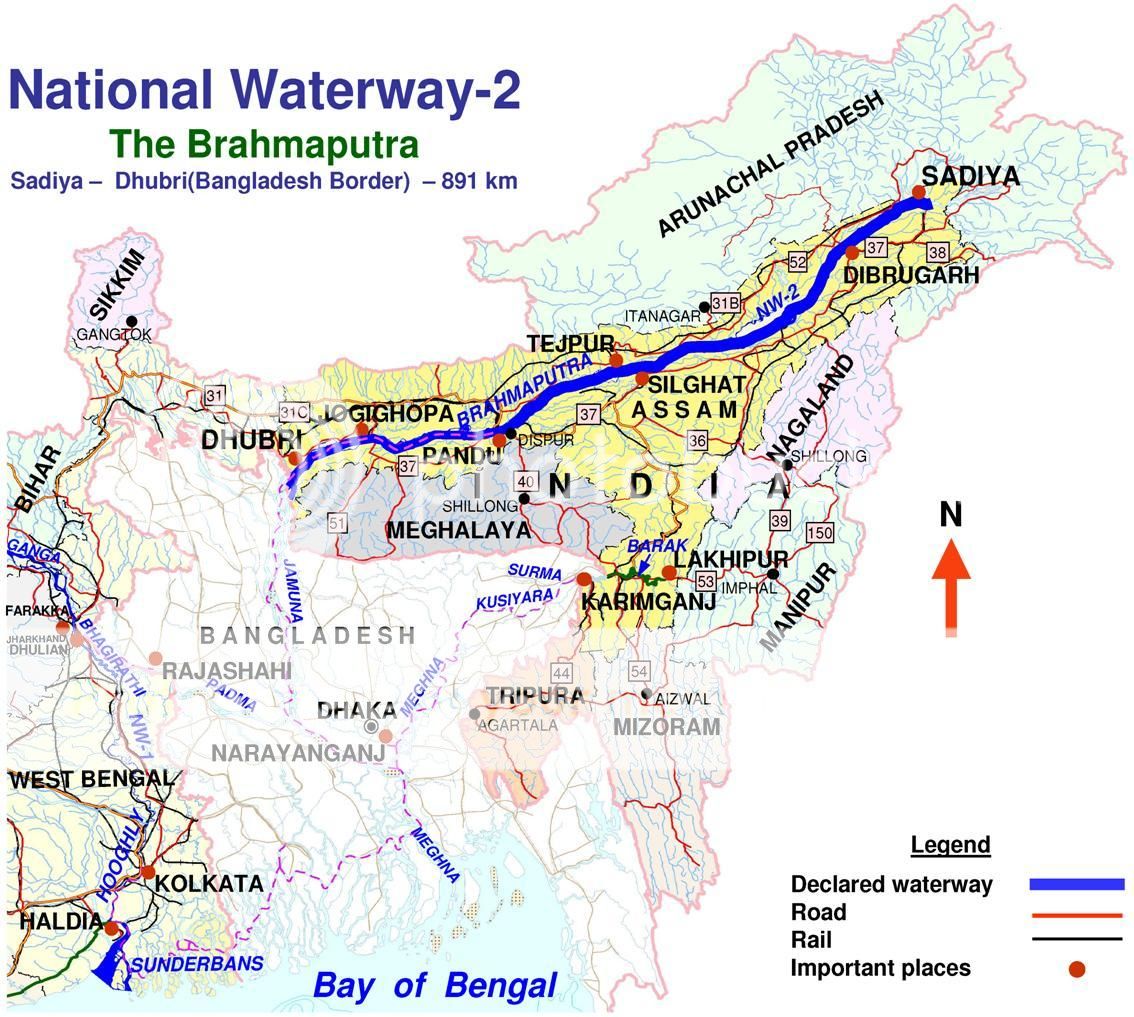Inland Water Transport ( IWT ) has played an important role in Indian transport since ancient times. But due to the expansion of road and rail transport, the importance of this mode has declined considerably. The potential of IWT to encourage and support economic and social development is huge, more so in a developing nation where resources are scarce.
India has inland waterways with a navigable length of 14,500 km, but of this only 5,700 km is being used for navigation by mechanized vessels. IWT, accounts for less than a 1% share of goods transported within India . The Government aims to develop IWT as a complementary service in a multi-modal transport network.
The Inland Waterways Authority of India (IWAI), created in 1986 is responsible for development and regulation of inland waterways for shipping and navigation. The Inland Waterways Authority of India Act, 1985 empowers the Government to declare waterways with potential for development of shipping and navigation as National Waterways and develop such waterways for efficient shipping and navigation. Five national waterways have been declared so far. Study these maps carefully. You should know the given NW passes through which state, major rivers involved etc.
National Waterways
[su_note note_color=”#bdf7f1″ text_color=”#000000″ radius=”0″]NW-1 – Allahabad-Haldia stretch of the Ganga- Bhagirathi- Hooghly river system – 1620 km [/su_note]
[su_note note_color=”#bdf7f1″ text_color=”#000000″ radius=”0″]NW-2 – Sadiya-Dhubri stretch of Brahmaputra river – 891 km [/su_note]
[su_note note_color=”#bdf7f1″ text_color=”#000000″ radius=”0″]NW-3 – Kollam-Kottappuram stretch of West Coast Canal, Champakara canal and Udyogmandal canal – 205 km [/su_note]
[su_note note_color=”#bdf7f1″ text_color=”#000000″ radius=”0″]NW-4 – Kakinada-Puducherry stretch of Canals and the Kaluvelly Tank, Bhadrachalam-Rajahmundry stretch of river Godavari and Wazirabad- Vijayawada stretch of river Krishna – 1078 km [/su_note]
[su_note note_color=”#bdf7f1″ text_color=”#000000″ radius=”0″]NW-5 – Talcher-Dhamra stretch of rivers, Geonkhali-Charbatia stretch of East Coast Canal, Charbatia-Dhamra stretch of Matai river and Mahanadi Delta rivers (588 km) [/su_note]
[su_note note_color=”#bdf7f1″ text_color=”#000000″ radius=”0″]The National Waterway (Lakhipur-Bhanga Stretch of the Barak River) Bill, 2013 was introduced in the Rajya Sabha in 2013. The Bill proposes to declare and develop the 121km long Lakhipur-Bhanga stretch of the Barak river in Assam as National Waterway 6 – NW-6. [/su_note]
Benefits of IWT
- Low capital cost and operating costs
- Low maintenance cost
- Least energy consumption – highly fuel efficient mode of transport.
- Least impact on environment among other modes of transport – low carbon emissions.
- Enormous capacity reserves to carry bulk cargo, coal etc
- Can provide access to far flung areas -. North Eastern states now receive coal, foodgrains through IWT.
Constraints in development of IWT
- Diversion of river water for irrigation – Volume of water in the rivers has lessened on account of construction of canals for irrigation purposes.
- Deforestation of hill ranges leading to erosion, accumulation of silt in rivers.
- Insufficient depths throughout the stretch of navigable waters . For example, the peninsular rivers depend on rainfall for their volume of water. During dry season, navigation is difficult.
- Most of the large rivers of the country enter the sea through shallow sand choked delta channels. Thus navigation is hampered unless dredging is done.
- Non availability of adequate navigational aids resulting in unsafe passage and high travel time.
- Lack of adequate terminal facilities at the loading and unloading points.
- Lack of investment for the creation of infrastructure, modernization and lack of efficient operators.
- Fuel cost is another factor. The barges run on high-speed diesel, the same fuel used by trucks. If diesel prices soar, it will be disadvantageous.
- Environmentalists have criticized the move to construct dams for promoting IWT as it will have an adverse impact on the ecology.
Suggestions to develop IWT
- There is a need to give adequate financial support for operationalising these waterways. 12th FYP allocated only 1500 cr. Government should come out with comprehensive projects for development of IWT and fund allocations for the same should be made accordingly.
- In Budget 2014-15 the following proposal was made : – There should be development of inland waterways to improve the capacity for the transportation of goods. A project on the river Ganga called ‘Jal Marg Vikas’ (National Waterways-I) will be developed between Allahabad and Haldia to cover a distance of 1620 kms, which will enable commercial navigation of at least 1500 tonne vessels. The project will be completed over a period of six years at an estimated cost of Rs 4,200 crore.
- Interlinking waterways and ports with coastal shipping – for example Ganga- Brahmaputra – Sunderbans river system can be integrated with Haldia and Kolkata ports. This will have a domino effect of development of that area, and also relieve pressure on the land based modes.
- Increasing the role of private sector in development of infrastructure and services in IWT sector on PPP basis. 12th FYP mentions that there should be an increased investment from private sector in the IWT sector. Private sector can increase involvement in operations of vessels for cargo and passenger movement, construction and operation of terminals, fairways and river ports, setting of IWT training institutions.
- Container mode of transport should be promoted in the area using multi-modal transit route through Bangladesh, which may ease the transport of essential commodities to the North Eastern states. An inland water transport transit and trade protocol already exists between India and Bangladesh for NW-II. The government should strive further to promote connectivity with Bangladesh.
India needs to study the viability and means to attract more investment to the IWT sector, by creating an institutional framework. IWT should be a part of the National Maritime Development Programme. The enhanced level of involvement of the private sector in IWT that has now been initiated is a welcome step. More waterways should be identified for development, and those earmarked given a push. IWT as a mode of transportation should not be considered in isolation. It should be integrated with other modes to achieve optimum benefits for the national economy.
[su_divider divider_color=”#322e69″ link_color=”#0c0b0b” margin=”120″]



Leave a Reply